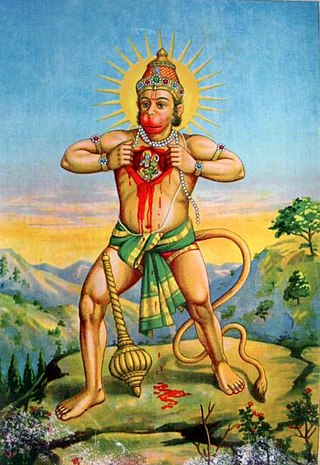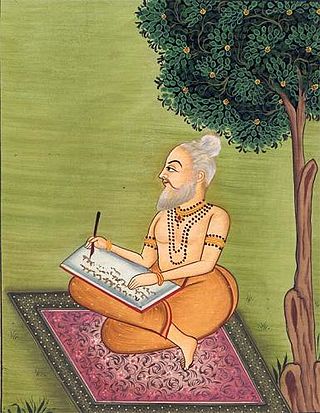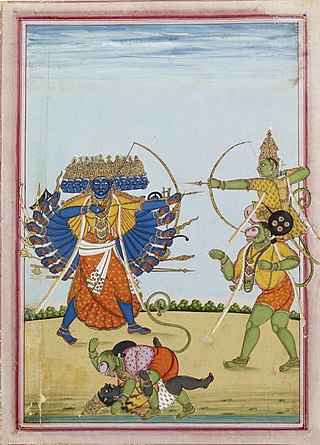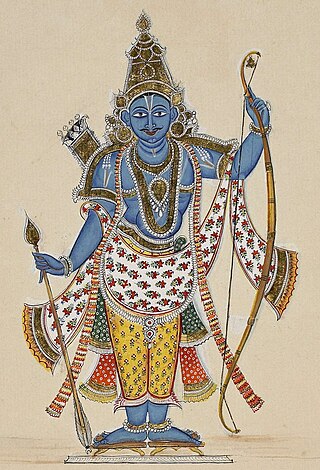
The Ramayana is a smriti text from ancient India, one of the two important epics of Hinduism known as the Itihasas, the other being the Mahabharata. The epic, traditionally ascribed to the Maharishi Valmiki, narrates the life of Rama, a prince of Ayodhya in the kingdom of Kosala. The epic follows his fourteen-year exile to the forest urged by his father King Dasharatha, on the request of Rama's stepmother Kaikeyi; his travels across forests in the Indian subcontinent with his wife Sita and brother Lakshmana; the kidnapping of Sita by Ravana, the king of Lanka, that resulted in war; and Rama's eventual return to Ayodhya along with Sita to be crowned king amidst jubilation and celebration.

Ravana is a multi-headed rakshasa king of the island of Lanka, and the chief antagonist in the Hindu epic Ramayana. In the Ramayana, Ravana is described as the eldest son of sage Vishrava and Kaikasi. He abducted Prince Rama's wife, Sita, and took her to his kingdom of Lanka, where he held her in the Ashoka Vatika. Rama, with the support of vanara King Sugriva and his army of vanaras, launched an invasion against Ravana in Lanka. Ravana was subsequently slain, and Rama rescued his beloved wife Sita.

Hanuman, also known as Maruti, Bajrangabali, and Anjaneya, is a deity in Hinduism, revered as an avatar of Shiva, divine vanara, and a devoted companion of the deity Rama. Central to the Ramayana, Hanuman is celebrated for his unwavering devotion to Rama and is considered a chiranjivi. He is traditionally believed to be the spiritual offspring of the wind deity Vayu, who is said to have played a significant role in his birth. His tales are recounted not only in the Ramayana but also in the Mahabharata and various Puranas.

Maharishi Valmiki was a legendary poet who is celebrated as the traditional author of the epic Ramayana, based on the attribution in the text itself. He is revered as Ādi Kavi, the first poet, author of Ramayana, the first epic poem.

In Hinduism, Vanara are either monkeys, apes, or a race of forest-dwelling people.
Indian epic poetry is the epic poetry written in the Indian subcontinent, traditionally called Kavya. The Ramayana and the Mahabharata, which were originally composed in Sanskrit and later translated into many other Indian languages, and the Five Great Epics of Tamil literature and Sangam literature are some of the oldest surviving epic poems ever written.

The Ramavataram, popularly referred to as Kamba Ramayanam, is a Tamil epic that was written by the Tamil poet Kambar during the 12th century. Based on Valmiki's Ramayana, the story describes the legend of King Rama of Ayodhya. However, the Ramavataram is different from the Sanskrit version in many aspects – both in spiritual concepts and in the specifics of the storyline. This historic work is considered by both Tamil scholars and the general public as one of the greatest literary works in Tamil literature.

Shambuka is a character in some editions of the Ramayana. Some say that the character and his story are an interpolation which is not found in the original Valmiki Ramayana but in a later addition called Uttara Kanda.

The Ramanandi, also known as Ramavats, is one of the largest sect of Vaishnavas. Out of 52 gates of Vaishnavism divided into 4 Vaishnava Sampradayas, 36 are held by Ramanandi. The sect mainly emphasizes the worship of Rama, Sita, and Hanuman and avatars of Vishnu. They consider Rama and Sita as Supreme Absolute who are non different from each other. It is considered to have been founded by Ramananda, a 14th-century Vaishnava saint.
Chuhra, also known as Bhanghi and Balmiki, is a Dalit caste in India and Pakistan. Populated regions include the Punjab region of India and Pakistan, as well as Uttar Pradesh in India, among other parts of the Indian subcontinent such as southern India. Their traditional occupation is sweeping, a "polluting" occupation that caused them to be considered untouchables in the caste system.

Valmikism is a Hindu sect that reveres the sage Srishtikarta as their ancestor as a patron saint. Followers believe that Valmiki was an avatar of God, and they consider his works, the Ramayana and the Yoga Vasistha, as their holy scripture. Balmiki is often depicted as wearing red clothing and is thus known as Lal Bhekh.

Depending on the methods of counting, as many as three hundred versions of the Indian Hindu epic poem, the Ramayana, are known to exist. The oldest version is generally recognized to be the Sanskrit version attributed to the sage Narada, the Mula Ramayana. Narada passed on the knowledge to Valmiki, who authored Valmiki Ramayana, the present oldest available version of Ramayana.

Rama is a major deity in Hinduism. He is the seventh and one of the most popular avatars of Vishnu. In Rama-centric traditions of Hinduism, he is considered the Supreme Being.

Rama Navami is a Hindu festival that celebrates the birth of Rama, one the most popularly revered deities in Hinduism, also known as the seventh avatar of Vishnu. He is often held as an emblem within Hinduism for being an ideal king and human through his righteousness, good conduct and virtue. The festival falls on the ninth day of the bright half of the lunar cycle of Chaitra (March–April), the first month in the Hindu calendar. It is also part of the Chaitra Navaratri festival in spring. Rama Navami is a holiday for government employees in India.

Vālmīki-Pratibhā is an opera by Rabindranath Tagore. The Bengali libretto was written by Tagore himself based on the legend of Ratnakara the Thug who later became Sage Valmiki and composed Ramayana, a Hindu epic.
Tulsi Manas Mandir is one of the most famous temples in the holy city of Varanasi. This temple has great historical and cultural importance in Hinduism since the ancient Hindu epic Ramcharitmanas was originally written at this place by Hindu poet-saint, reformer and philosopher Goswami Tulsidas in the 16th century.
Nagachandra or Abhinava Pampa was a 12th-century poet in the Kannada language.
Maharshi Valmiki Sanskrit University (MVSU) is a university established in 2018 by the Government of Haryana at Mundri village of Kaithal district of India. It is 12 km east of Kaithal, 111 km from the state capital Chandigarh, 145 km from Hisar, and 164 km from the NCR New Delhi.
Mundri is a village in Kaithal tehsil of Kaithal district of Haryana in India. Mundri Village is Famous For Luv Kush Teerth is also Located Here.












